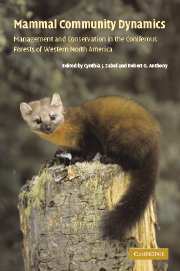 Mammal Community Dynamics
Mammal Community Dynamics Foreword
Published online by Cambridge University Press: 15 December 2009
Summary
Until the late 1970s, biologists tended to deal with one species at a time in terms of consideration in forest management. By that time, the consequences and requirements of the plethora of environmental laws passed during that decade (and the regulations issued pursuant to those laws) were coming to bear through land-use planning and court actions.
Managers and biologists were suddenly faced with having to broaden their considerations to include the entire spectrum of wildlife species in both planning and management. One phase in the planning regulations developed by the US Forest Service to be responsive to the cumulative requirements of the National Environmental Policy Act, The Endangered Species Act, and the National Forest Management Act was to play a critical role in changing biologists' focus and activities. Those regulations required that “ … viable populations of all native and desirable non-native vertebrates be maintained within the planning area.” And, as a result, the world of forest managers and biologists was forever changed.
The first try at summarizing information on the relationship of the entire spectrum of wildlife species to forest habitats was developed in 1976 and published in 1979 (Thomas 1979). It was specific to the Blue Mountains of Oregon and Washington and was based on published information and expert opinion. At the time, the balance was tilted more toward expert opinion relative to hard data.
That effort was quickly emulated for a number of ecosystems in the United States and elsewhere in the world.
- Type
- Chapter
- Information
- Mammal Community DynamicsManagement and Conservation in the Coniferous Forests of Western North America, pp. xvii - xviiiPublisher: Cambridge University PressPrint publication year: 2003


